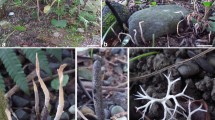Abstract
Two xylariaceous fungi were isolated from a nest of a termite, Odontotermes formosanus, that was incubated in a laboratory after collecting from Iriomote Is., Okinawa Pref., in Japan. One of the two fungi was identified as Xylaria angulosa on the basis of the morphology of branched stroma produced on medium, tiny asci, and ascospores having a germ slit. Another fungus is an anamorphic fungus that produces synnemata up to 50 mm long from which dendritic conidiophores branch out. Unicellular conidia are holoblastically produced on a sympodially proliferating conidiogenous cell. Such morphological characters resemble those of the genus Geniculosporium. However, its distinctive synnema formation and dendritic conidiophores do not assign the fungus to Geniculosporium or other known genera and warrant establishment of a new genus. The phylogenetic tree based on the ITS regions of rDNA shows that the fungus is nested in the cluster of the genus Nemania (Xylariaceae), whose species have mainly Geniculosporium-like anamorphs. We describe here the present anamorphic fungus as Geniculisynnema termiticola gen. et sp. nov., and discuss its phylogenetic and ecological relationships to xylariaceous fungi, especially termiticolous species.
Similar content being viewed by others
References
CGC Chesters GN Greenhalgh (1964) ArticleTitle Geniculosporium serpens gen. et sp. nov., the imperfect state of Hypoxylon serpens Trans Br Mycol Soc 47 393–401
PA Dixon (1965) ArticleTitleThe development and liberation of the conidia of Xylosphaera furcata Trans Br Mycol Soc 48 211–217
J Felsenstein (1985) ArticleTitleConfidence limits on phylogenies: an approach using the bootstrap Evolution 39 783–791 Occurrence Handle10.2307/2408678
H-M Hsieh Y-M Ju JD Rogers (2005) ArticleTitleMolecular phylogeny of Hypoxylon and closely related genera Mycologia 97 844–865 Occurrence Handle16457354 Occurrence Handle1:CAS:528:DC%2BD2MXht1ClsrrF
KD Hyde TK Goh (1998) ArticleTitleTropical Australian freshwater fungi XIII. A new species of Anthostomella and its sporodochial Geniculosporium anamorph Nova Hedwigia 67 225–233
Y-M Ju JD Rogers (1996) ArticleTitleA revision of the genus Hypoxylon Mycol Mem 20 1–365
Y-M Ju JD Rogers (1999) ArticleTitleThe Xylareaceae of Taiwan (excluding Anthostomella) Mycotaxon 73 343–440
M Kimura (1980) ArticleTitleA simple method for estimating evolutionary rates of base substitutions through comparative studies of nucleotide sequences J Mol Evol 16 111–120 Occurrence Handle7463489 Occurrence Handle10.1007/BF01731581 Occurrence Handle1:CAS:528:DyaL3MXmtFSktg%3D%3D
JW Paden JR Sutherland TAD Woods (1978) ArticleTitleCaloscypha fulgens (Ascomycetidae, Pezizales): the perfect state of the conifer seed pathogen Geniculodendron pyriforme (Deuteromycotina, Hyphomycetes) Can J Bot 56 2375–2379
G Perrière M Gouy (1996) ArticleTitleWWW-Query: an on-line retrieval system for biological sequence banks Biochimie (Paris) 78 364–369
LE Petrini O Petrini (1985) ArticleTitleXylariaceous fungi as endophytes Sydowia 38 216–234
LE Petrini JD Rogers (1986) ArticleTitleA summary of the Hypoxylon serpens complex Mycotaxon 26 401–436
KF Rodrigues O Petrini (1997) Biodiversity of endophytic fungi in tropical regions KD Hyde (Eds) Biodiversity of tropical microfungi Hong Kong University Press Hong Kong 57–69
JD Rogers (1985) ArticleTitleAnamorphs of Xylaria: taxonomic considerations Sydowia 38 255–262
JD Rogers BE Callen GJ Samuels (1987) ArticleTitleThe Xylariaceae of the rain forests of north Sulawesi (Indonesia) Mycotaxon 29 113–172
JD Rogers Y-M Ju J Lehmann (2005) ArticleTitleSome Xylaria species on termite nests Mycologia 97 914–923 Occurrence Handle16457361 Occurrence Handle10.3852/mycologia.97.4.914
CV Sabramanian (1972) ArticleTitle Padixonia, a new genus of Hyphomycetes Curr Sci 41 282–283
N Saitou M Nei (1987) ArticleTitleThe neighbor-joining method: a new method for reconstructing phylogenetic tree Mol Biol Evol 4 406–425 Occurrence Handle3447015 Occurrence Handle1:STN:280:DyaL1c7ovFSjsA%3D%3D
GA Salt (1974) ArticleTitleEtiology and morphology of Geniculodendron pyriforme gen. et sp. nov., a pathogen of conifer seeds Trans Br Mycol Soc 63 339–351 Occurrence Handle10.1016/S0007-1536(74)80179-8
J Sánchez-Ballesteros V González O Salazer J Acero MA Portal M Julián V Rubio GF Bills JD Polishook G Platas S Mochales F Pelaez (2000) ArticleTitlePhylogenetic study of Hypoxylon and related genera based on ribosomal ITS sequences Mycologia 92 964–977 Occurrence Handle10.2307/3761591
Sivanesan A, Holliday P (1972a) Rosellinia bunodes. CMI (Commonw Mycol Inst) Descr Pathog Fungi Bact No 351
Sivanesan A, Holliday P (1972b) Rosellinia necatrix. CMI (Commonw Mycol Inst) Descr Pathog Fungi Bact No 352
Sivanesan A, Holliday P (1972c) Rosellinia arcuata. CMI (Commonw Mycol Inst) Descr Pathog Fungi Bact No 353
Sivanesan A, Holliday P (1972d) Rosellinia pepo. CMI (Commonw Mycol Inst) Pathog Fungi Bact 354
JD Thompson TJ Gibson F Plewniak F Jeanmougin DG Higgins (1997) ArticleTitleThe CLUSTAL_X windows interface: flexible strategies for multiple sequence alignment aided by quality analysis tools Nucleic Acids Res 25 4876–4882 Occurrence Handle9396791 Occurrence Handle10.1093/nar/25.24.4876 Occurrence Handle1:CAS:528:DyaK1cXntFyntQ%3D%3D
D Triebel D Persoh H Wollweber M Stadler (2005) ArticleTitlePhylogenetic relationships among Daldinia, Entonaema and Hypoxylon as inferred from ITS nrDNA analyses of Xylariales Nova Hedwigia 80 25–43 Occurrence Handle10.1127/0029-5035/2005/0080-0025
K Ueda K Mikata (1999) ArticleTitleA group I intron in the nuclear 18S rRNA gene of the yeast-like fungus, Arxula terrestris IFO Res Commun 19 15–21
AJS Whalley RL Edwards SM Francis (1983) ArticleTitle Hypoxylon gwyneddii sp. nov. from Wales Trans Br Mycol Soc 81 389–392
TJ White T Bruns S Lee J Taylor (1990) Amplification and direct sequencing of fungal ribosomal DNA for phylogenetics MA Innis DH Gelfand JI Sninsky TJ White (Eds) PCR protocols: a guide to the methods and applications Academic Press San Diego 315–322
Author information
Authors and Affiliations
Corresponding author
About this article
Cite this article
Okane, I., Nakagiri, A. Taxonomy of an anamorphic xylariaceous fungus from a termite nest found together with Xylaria angulosa . Mycoscience 48, 240–249 (2007). https://doi.org/10.1007/s10267-007-0361-9
Received:
Accepted:
Published:
Issue Date:
DOI: https://doi.org/10.1007/s10267-007-0361-9




